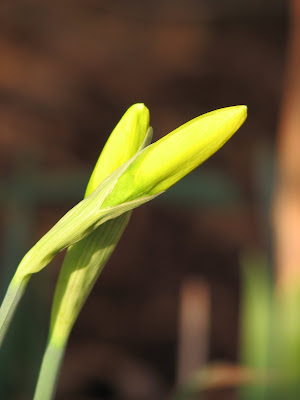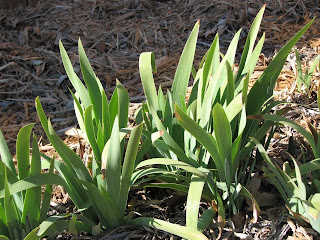February 28, 2009
February 27, 2009
Maybe Tomorrow
It seems that everywhere CG goes, he sees daffodils in bloom. Everywhere, that is, except his garden.
Maybe tomorrow.
February 25, 2009
Maintaining a mustache
...I mean, mulch stash...
In order to maximize TiG (time in garden) CG strives to complete basic upkeep of the planting beds during the cold, dormant months. This requires having mulching products on-site and ready to go at all times. It's not fun to spend a nice warm day running around town picking-up supplies and missing-out on prime gardening time. CG will add mulch to the planting beds to a uniform 4" depth. He will purchase more than he actually needs, in order to maintain a surplus of mulch. An ideal 'mulch stash' for CG would include: 2 bales of pine needles, 9 cubic feet of cypress mulch, 4 cubic feet of pine bark, and a recycled 3 cubic ft. bag stuffed with self-made canna mulch.
Dormant-time bed maintenance includes: removal of wintering weeds, pruning, and checking to ensure proper mulch depth. The azalea bed was mulched with pine needles, but this year, a base layer of pine bark was added (with the pine needles layered on top). Iris also prefer an acidic mulch, so CG will be going to the local farmer's co-op for more bales of pine needles. Once the pine needles are in place and become weathered-in, they tend to stay put, without being blown away by the wind, or washed away by the rain.
In a few weeks, transplanting will have to be completed in a timely manner, to get the plants somewhat established before the hot, dry summer weather. When plants are being moved-around, it's a good idea to have mulch on-hand and ready to insulate a moist growing medium (so don't allow the mulch stash to be depleted during the dormant-time bed maintenance! -note to self). Fall is the ideal season to transplant, but CG is a little impatient. He's had good results moving/dividing daylilies, iris, daffodils, and newly rooted forsythia in early spring. Established shrubs and small trees require more frequent waterings and tlc (to include using framed bird netting to shade plant from the overly-harsh afternoon sun). If at all possible, delay the transplanting of mature shrubs and trees until the fall.
February 23, 2009
California Poppies
Day 5:
CG is very impressed with his 20 cent seed purchase. The poppies seem to be in a hurry and are working really hard to achieve plant status. By late March, they should be vibrant, healthy, and ready for a prolonged display of bright orange blooms.
(CG started the seed-sowing process with the impatiens and hopes it goes as well as the poppies!)
(CG decided to save $5 and use a recycled microwave food tray filled with peat moss as the growing medium for the second batch of seedlings...it has a black base, clear top -should work just as well)
February 22, 2009
First California Poppy Seed Sprouts
Earlier this evening, CG was moving the planting tray from the window area (no direct light just yet) to the top of the fridge (stays warmer up on top). He noticed something. Surely it was something in the peat that just looked like a sprout. He popped the lid for a better look. Amazing. At least 6 sprouts in only 4 days. He's being careful not to add too much water, and has propped-open the lid. Once all of the seeds have sprouted, the lid will be removed.
February 21, 2009
South side of house bed
22 March 2008:
This is one of the newer beds. The area was 'put on the back burner' (neglected) for a long time by CG. Last March, CG began the task of extending the cement trench all the way around to the back fence. It quickly became a very large bed. Luckily, CG had surplus landscape blocks, plenty of cannas, 3 low-growing crepe myrtles, a good sized burning bush, and a 3 gallon sized crepe myrtle. The blocks were used for an oblong shaped planting area for the cannas. The low-growing crepe myrtles were planted as a border between the canna planting area and the edge of the trench. The burning bush was planted on the far end of the cannas. A small rock path leads from the edge of the trench to the water spigot. On the far side of the rock path, the (possibly) regular sized crepe myrtle was planted.
21 FEB 2009:
This is definitely a low-maintenance bed. All of the plants are drought-tolerant and require little upkeep. Just the way CG likes it.
21 FEB 2009:
Future plans for this bed include planting a few good starts of creeping jenny as ground cover this spring. Maybe in the fall, CG will dig-in a few patches of daffodils and extend the iris further down towards the fence.
February 19, 2009
California Poppies
CG has decided to add some flora to the burning bush bed. A quick stop to the nursery for some instant results once spring arrives would be too easy. Never having attempted growing annuals from seed before, CG needed something to do in the waning weeks of winter to keep him occupied.
These particular seeds were chosen for their drought-tolerance and full-sun characteristics (and CG feels that he is doing his part to help-out the economy in California -he's sure Gov. Terminator gets royalties from everything sold with 'California' on its label).
February 17, 2009
Iris
This year, CG will start growing Louisiana iris (mail-ordered 2 plants). A special planting area has been readied for their arrival (in about a month). The area is appx. 5' x 4' and 8 inches deep. Louisiana iris thrive in boggy areas, so the bed was lined with a plastic tarp and 2 mil plastic sheeting. It was then filled with shaved clay (unscented kitty litter). Once the bareroot iris arrive, they will be soaked in water overnight, prior to being planted. About an inch of sand will be added to the top of the bed, along with a top dressing of pine straw. Two different varieties will be planted, with the idea that once they begin to multiply, another 'bog bed' in the front side yard will have been completed.
February 15, 2009
Mid February Landscape Notes
- should have divided more iris last fall
- iris that were divided have multiple new shoots coming-up
- thinking it would have been ok to fertilize the 'new born' forsythia last fall (fertilized the mature plants after they dropped leaves)
- had more wild temperature swings -highs ranging from the 40's to the 70's
- will have plenty of cannas (50+) to trade and/or giveaway
- crepe myrtle pruning completed this month
- low-growing crepe myrtles have spread-out nicely
- finally had some good rain last week
- burning bush bed looks good, has been low maintenance
- decided to remove all of the cannas from the cut flower bed
February 13, 2009
Ready for some daffodils!
February 9, 2009
Fewer wintering weeds
The most effective weed control method used by CG is pulling them by hand. After a good rain, he can be found in the front yard surveying each square inch. If he had all of his wits, CG would have never started the task, which at first seemed impossible. The grass blades were probably well outnumbered by the wide variety of weeds.
February 7, 2009
Blue Ridge Parkway
February 5, 2009
Mystery annuals
The plants were located in the annuals section when they were purchased last spring. However, cold weather does not seem to phase them. So, chances are that these perennials were an unintentional good choice for the deep shade front door planters.
February 3, 2009
Garden tool belts
February 1, 2009
River Birch trees
March 2005:
The river birch trees have done well over the past few years. They grow relatively fast -meaning they don't look like dinky nursery-bought trees for too long. They do need a little help with extra watering during periods of drought. Sun-tolerant plants are still able to thrive underneath the canopy, which offers light shade. There was an issue with one bagworm nest during the late summer, but CG was ready for the challenge and quickly dispatched them.
March 2007:
The trees are pruned each winter, and each time CG pauses to wonder if he got a little carried-away with the pruners. C'est la vie. If you don't think you can live with it, it's best to do away with it -is CG's pruning motto.

In May 2007, the river birch that was closest to the house was moved. It had a rough summer, followed by a late freeze (after it had set leaves) the following spring. Now it is noticeably smaller than its siblings. It was moved to offer a more balanced transition from the yard to the planting bed (and maybe it was planted a little too close to the house to begin with, but CG will never admit to that!)
February 2009:
The river birch were fertilized with a 12-10-10 sprinkling, cast from their driplines outwards to about 6 feet. This was done in the fall, after they dropped all of their leaves, and will be repeated in the spring a couple weeks after the last freeze. CG is expecting good things from his river birch this year!


































